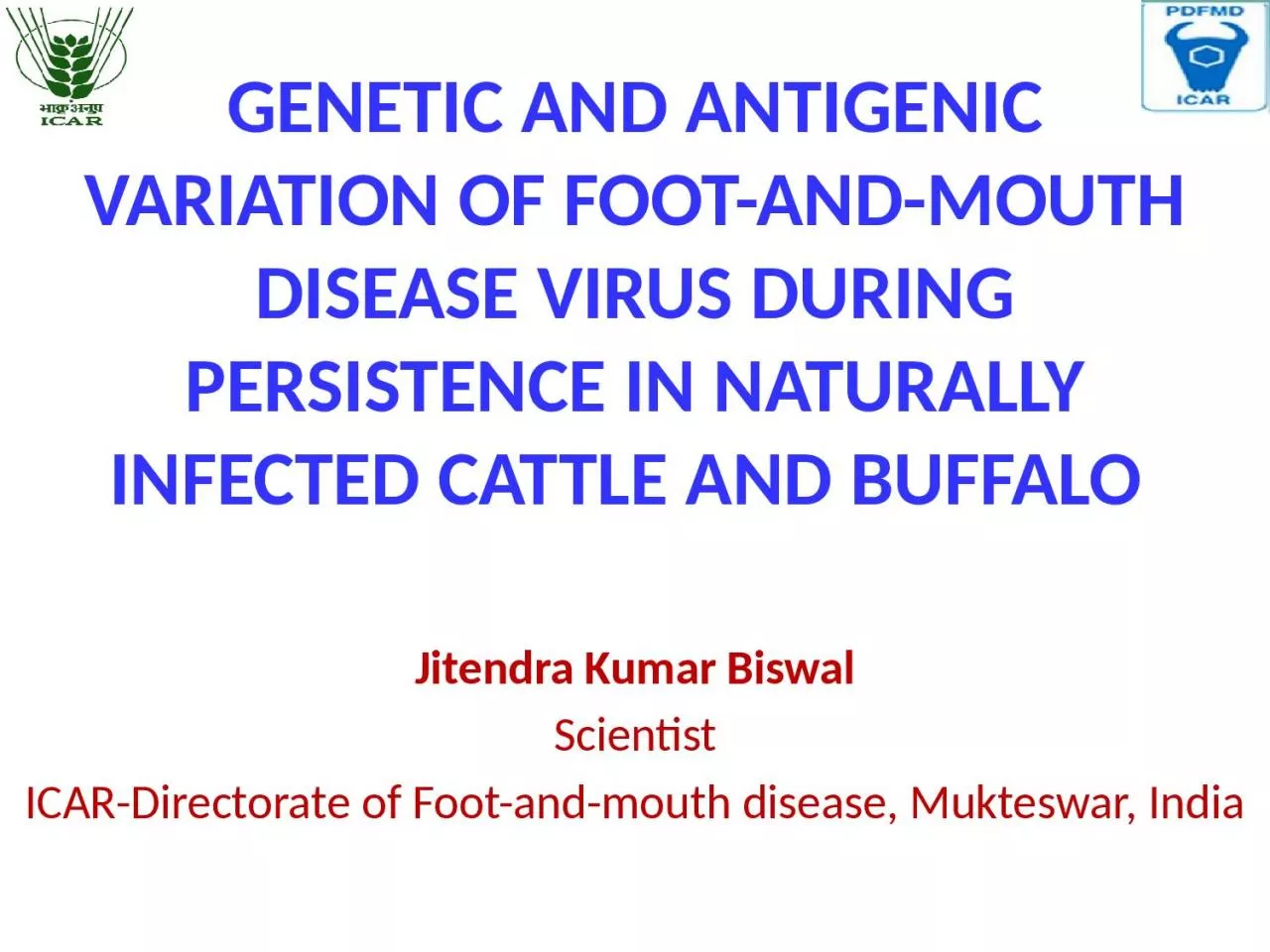

Jitendra Kumar Biswal Scientist ICARDirectorate of Footandmouth disease Mukteswar India Need to study FMDV persistence in endemic settings Better understanding of FMDV natural ecology for development of effective control strategies ID: 1041467
Download Presentation The PPT/PDF document "GENETIC AND ANTIGENIC VARIATION OF FOOT-..." is the property of its rightful owner. Permission is granted to download and print the materials on this web site for personal, non-commercial use only, and to display it on your personal computer provided you do not modify the materials and that you retain all copyright notices contained in the materials. By downloading content from our website, you accept the terms of this agreement.
1. GENETIC AND ANTIGENIC VARIATION OF FOOT-AND-MOUTH DISEASE VIRUS DURING PERSISTENCE IN NATURALLY INFECTED CATTLE AND BUFFALO Jitendra Kumar BiswalScientistICAR-Directorate of Foot-and-mouth disease, Mukteswar, India
2. Need to study FMDV persistence in endemic settingsBetter understanding of FMDV natural ecology for development of effective control strategies.Possible roles of persistently infected animals in initiating new outbreaksQuantification of risk posed by carriersEnhance our understanding on the basic biology of FMDV
3. ABIS Dairy, Rajnandagaon, Chhattisgarh Biggest Dairy in Central India; Total Population= 5000; animals on milch = 1836
4. FMD outbreak summary at ABIS Dairy Routine VaccinationIndex case on 24th December 2013.222 clinical cases out of 1836 animals over a course of 35 days of infection, with an cumulative incidence rate : 12.1%
5. Study DesignUp to total 21 clinically affected and 16 asymptomatic cattle ; 11 clinically affected and 6 asymptomatic buffalo were sampled for O-P fluids at 2-3 months interval for a period of 13 months.Viruses were rescued from OPF in LFBK-αVβ6 cells and the entire capsid coding (P1) sequences were determined from the cell culture supernatant at low passage level (3-4).
6. Genome Detection
7. Virus Isolation
8. Virus Isolation on LFBK-αVβ6 cell line
9. ML tree depicting the phylogentic relationships of carrier and acute viruses of abis farm
10. Nucleotide divergence of virus from carrier animals compared to virus collected during acute phase of infection Mean dN/dS (ω)= 0.188 2.4%
11. Distribution of synonymous/non-synonymous variations at P1 regionVP4 (1-85) VP2(86-303) VP3 (304-523) VP1(525-734)
12. Genetic Variation at Herd LevelOverall, in the capsid coding region, a total 304 sites (13.8%) were found to be polymorphic, of which 208 sites showed single nt polymorphism (9.4%) and 96 sites were shared by more than 2 nts (4.3%). Among the base substitutions, maximum (86%) were transitions and 14% were transversions.The capsid protein in carrier viruses showed variations at 75 aa positions (10.2%) of which 66 positions (8.9%) were occupied alternately by two aa and 9 positions (1.2%) were substituted by more than two aa.30 sites: VP1, 23 sites: VP3 and 17 sites: VP2.
13. Selection Pressure AnalysisTwo codons in VP1 (138 and 148) and one codon each in VP2 (78) and VP3 (76) to be under positive selection with statistical significance as determined by SLAC, FEL and IFEL methods. Additionally, codon 73 in VP3 was found to be under selection pressure by SLAC and FEL.A total of 28 codons was found to experience episodic diversifying selection. Of which, 10 codons were in VP3 followed by 9 in VP1 and 8 in VP2.VP4 revealed one codon (61) to be under episodic selection
14. Statistical parsimony analysis of capsid coding sequences of acute and carrier virusesMay’14 : CC12517 and CB2224, Aug’14 : CB1816 and AB1932, Nov’14: CB1964 and Feb’15: CB16403 have >1% nucleotide divergence from acute virus
15. Evolutionary rates By using the relaxed lognormal molecular clock model, the mean nucleotide substitution was estimated to be was estimated to be 1.816 x 10-2 substitution/site/year (s/s/y) with a 95% CI: 1.362-2.31 x 10-2 s/s/y. The average mutation rate of codon positions 1+2 and 3 was estimated to be 0.519 and 1.963, respectively.This substitution rate is significantly faster than the rates reported earlier for Ind2001 lineage of serotype O virus Indian virus isolates over a period of 12 years (6.338 x 10-3 s/s/y).This clearly indicates higher selection pressure on virus genome during persistent infection
16. Antigenic relationship (r-value) obtained in 2D-MNT of the acute and carrier viruses Jan’14March’14May’14Aug’14Nov’14Feb’15C6670 (acute)0.6C5636 (acute)0.6Carrier virusCC125170.330.522CC51430.78CC202520.32CC202130.360.41CB164030.660.21CB19640.410.3830.3960.173CB22240.330.22CB19080.33CB18540.330.1430.277AC35950.490.295AC35120.33AC35680.230.819AC30350.66AB19320.229AB20170.248
17. Location of Putative antigenic sites on neutralization-resistant FMDV VP1-13 (T-S), VP1-54 (M-L), VP1-143 (N-K), VP3-123 (I-V), VP3-131 (E-A), VP3-203 (A-V)
18. Location of amino acids possibly responsible for high antigenicity 2194 A-P3166 D-G
19. Summary Mutations at the rate of 1.816 x 10-2 substitution/site/year (s/s/y). Fixation of nucleotide and amino acid changes were observed at some position, majority were not conserved in consecutive isolates. Between different animals, mean dN/dS (ω) value of the entire capsid coding region varies from 0.076 to 0.357. From the statistical parsimony analysis, it was evident that all the virus isolates from carrier animals were originated from acute virus except six isolates. The antigenic relationship value indicates fluctuation of antigenic variants in carrier animals. Evidence of viral activity in the persistently infected animals under field scenario and probable role of host factor in shaping their evolution.
20. ABIS Dairy, Raipur, India. ICAR USDAAll the Scientific and technical staffs of ICAR-Directorate of FMD ACKNOWLEDGEMENTS